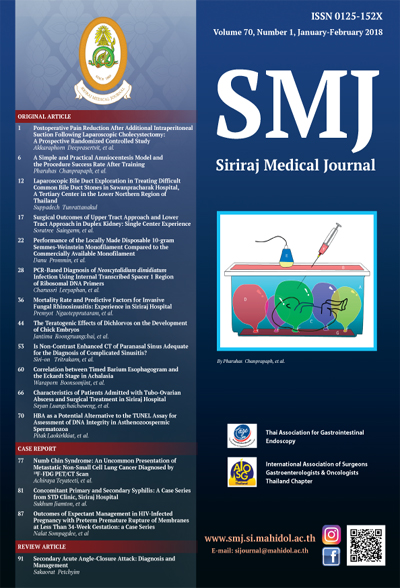Concomitant Primary and Secondary Syphilis: A Case Series from STD Clinic, Siriraj Hospital
Keywords:
Concomitant primary and secondary syphilis; syphilisAbstract
Objective: To emphasize the importance of dermatologists in identifying the presence of concomitant primary and secondary syphilis in the same patient in order to effectively diagnose the disease and provide adequate treatment.
Case presentation: The diversity of the clinical manifestations of syphilis is very common; however, atypical presentations of syphilis have a chance to occur. Such concomitant primary and secondary syphilis, which develops chancre concomitant rash is an uncommon manifestation. Cases of atypical syphilis have been described most frequently in patients with concomitant human immunodeficiency virus (HIV) infection and men who have sex with men (MSM).This report presents the cases of 8 patients with primary and secondary syphilitic lesions. These cases are representative because of their clinical presentation, age range, gender distribution and diagnostic approach.
Conclusion: The concomitant presence of primary and secondary syphilis in the same patient is unusual. The importance of our cases is to highlight some of the differences in clinical manifestations in HIV-infected men and HIV-uninfected men that might be important for early diagnosis for managing and curing such patients.
Downloads
Published
How to Cite
Issue
Section
License
Authors who publish with this journal agree to the following conditions:
Copyright Transfer
In submitting a manuscript, the authors acknowledge that the work will become the copyrighted property of Siriraj Medical Journal upon publication.
License
Articles are licensed under a Creative Commons Attribution-NonCommercial-NoDerivatives 4.0 International License (CC BY-NC-ND 4.0). This license allows for the sharing of the work for non-commercial purposes with proper attribution to the authors and the journal. However, it does not permit modifications or the creation of derivative works.
Sharing and Access
Authors are encouraged to share their article on their personal or institutional websites and through other non-commercial platforms. Doing so can increase readership and citations.











